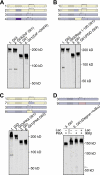A three-part signal governs differential processing of Gli1 and Gli3 proteins by the proteasome
- PMID: 21921029
- PMCID: PMC3234730
- DOI: 10.1074/jbc.M111.274993
A three-part signal governs differential processing of Gli1 and Gli3 proteins by the proteasome
Abstract
The Gli proteins are the transcriptional effectors of the mammalian Hedgehog signaling pathway. In an unusual mechanism, the proteasome partially degrades or processes Gli3 in the absence of Hedgehog pathway stimulation to create a Gli3 fragment that opposes the activity of the full-length protein. In contrast, Gli1 is not processed but degraded completely, despite considerable homology with Gli3. We found that these differences in processing can be described by defining a processing signal that is composed of three parts: the zinc finger domain, an adjacent linker sequence, and a degron. Gli3 processing is inhibited when any one component of the processing signal is disrupted. We show that the zinc fingers are required for processing only as a folded structure and that the location but not the identity of the processing degron is critical. Within the linker sequence, regions of low sequence complexity play a crucial role, but other sequence features are also important. Gli1 is not processed because two components of the processing signal, the linker sequence and the degron, are ineffective. These findings provide new insights into the molecular elements that regulate Gli protein processing by the proteasome.
Figures






Similar articles
-
Sonic Hedgehog-induced activation of the Gli1 promoter is mediated by GLI3.J Biol Chem. 1999 Mar 19;274(12):8143-52. doi: 10.1074/jbc.274.12.8143. J Biol Chem. 1999. PMID: 10075717
-
A novel protein-processing domain in Gli2 and Gli3 differentially blocks complete protein degradation by the proteasome.J Biol Chem. 2007 Apr 13;282(15):10846-52. doi: 10.1074/jbc.M608599200. Epub 2007 Feb 5. J Biol Chem. 2007. PMID: 17283082
-
GLI3-dependent transcriptional repression of Gli1, Gli2 and kidney patterning genes disrupts renal morphogenesis.Development. 2006 Feb;133(3):569-78. doi: 10.1242/dev.02220. Epub 2006 Jan 5. Development. 2006. PMID: 16396903
-
Gli proteins and the control of spinal-cord patterning.EMBO Rep. 2003 Aug;4(8):761-5. doi: 10.1038/sj.embor.embor896. EMBO Rep. 2003. PMID: 12897799 Free PMC article. Review.
-
The sonic hedgehog-patched-gli pathway in human development and disease.Am J Hum Genet. 2000 Nov;67(5):1047-54. doi: 10.1016/S0002-9297(07)62934-6. Epub 2000 Sep 21. Am J Hum Genet. 2000. PMID: 11001584 Free PMC article. Review. No abstract available.
Cited by
-
Single molecule microscopy reveals diverse actions of substrate sequences that impair ClpX AAA+ ATPase function.J Biol Chem. 2022 Oct;298(10):102457. doi: 10.1016/j.jbc.2022.102457. Epub 2022 Sep 5. J Biol Chem. 2022. PMID: 36064000 Free PMC article.
-
GLI3: a mediator of genetic diseases, development and cancer.Cell Commun Signal. 2020 Apr 3;18(1):54. doi: 10.1186/s12964-020-00540-x. Cell Commun Signal. 2020. PMID: 32245491 Free PMC article. Review.
-
Marching to the beat of the ring: polypeptide translocation by AAA+ proteases.Trends Biochem Sci. 2014 Feb;39(2):53-60. doi: 10.1016/j.tibs.2013.11.003. Epub 2013 Dec 6. Trends Biochem Sci. 2014. PMID: 24316303 Free PMC article. Review.
-
Control of Hedgehog Signalling by the Cilia-Regulated Proteasome.J Dev Biol. 2016 Sep 3;4(3):27. doi: 10.3390/jdb4030027. J Dev Biol. 2016. PMID: 29615591 Free PMC article. Review.
-
Hedgehog secretion and signal transduction in vertebrates.J Biol Chem. 2012 May 25;287(22):17905-13. doi: 10.1074/jbc.R112.356006. Epub 2012 Apr 2. J Biol Chem. 2012. PMID: 22474285 Free PMC article. Review.
References
-
- Hooper J. E., Scott M. P. (2005) Nat. Rev. Mol. Cell Biol. 6, 306–317 - PubMed
-
- Kent D., Bush E. W., Hooper J. E. (2006) Development 133, 2001–2010 - PubMed
-
- Zhang Q., Zhang L., Wang B., Ou C. Y., Chien C. T., Jiang J. (2006) Dev. Cell 10, 719–729 - PubMed
-
- Aza-Blanc P., Ramírez-Weber F. A., Laget M. P., Schwartz C., Kornberg T. B. (1997) Cell 89, 1043–1053 - PubMed
Publication types
MeSH terms
Substances
Grants and funding
LinkOut - more resources
Full Text Sources
Other Literature Sources
Molecular Biology Databases

